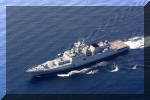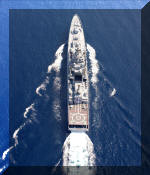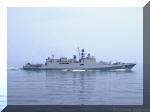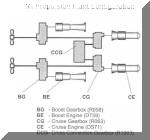TALWAR {KRIVAK III} CLASS
Vessel Type: Guided Missile Frigate, Type 1135.6
Names & Pennant Numbers with
commission dates:
INS Talwar F40; Laid Down - 10 March 1999, Launched - 12 May 2000,
Commissioned - 18 June 2003.
INS Trishul F43; Laid Down - 24 Sept 1999, Launched - 24 Nov 2000,
Commissioned - 25 June 2003.
INS Tabar F44; Laid Down - 26 May 2000, Launched - 25 May 2001,
Commissioned - 19 April 2004.
Ship Crest: The crest of a ship, akin to the 'Coat of Arms' of the Army or an 'Insignia' of the Air Force, epitomizes the spirit and ethos of the ship. Talwar was the most commonly used sword in Indian martial history. The blades varied in size, curvature and temper. According to Gatka - the Shastra from ancient Indian literature - Talwar is one of the Ten Weapons of the Gods. In lore, the Gods (embodying all that is Good) used these weapons in their numerous fights with the demons or 'Asuras' (embodying all that is evil). Talwar proved to be the foremost of them all and has been held in great esteem ever since. Through the ages Talwar has been the pride of India's many warrior classes, notable among them being the Rajputs, Sikhs and Marathas. "They are as careful of their swords and take as much pains to keep them in order as the Japanese do with their samurai," a British historian recorded. It is a common saying that a really objectionable act is as disgraceful as having a blunt sword. To the Indian Navy, the new INS Talwar represents the cutting edge of technology in stealth, reach and punch.
The word Trishul finds its origin from the Sanskrit word 'Tri' meaning three and 'Shul' meaning a spiked weapon. Consequently, this three-edged spiked weapon resembles a trident. Indian mythology has it that the Trishul was a powerful and all pervasive weapon of the Lord Shiva, that was effectively used by him to ward off evil. The Trishul as a weapon has been used ever since then to symbolise the victory of truth and righteousness over evil. According to mythology, surviving the onslaught of the Trishul is impossible. The crest of the ship depicts a strong arm rising out from under the sea, holding the powerful Trident. The mythological truth of this feared weapon, when extended to the INS Trishul makes the ship powerful in all three dimensions - air, surface and sub-surface. A warship that will be feared for her lethality and brutal power. The last vessel in the series is called Tabar - means Battle Axe in Sanskrit - and is aptly named for role, as she serves as an all-powerful weapon platform of the sea. The crest of the ship depicts a pair of battle axes, in a 'X' layout, rising out from under the sea.
Structure: The Severnoye (Northern) Design Bureau developed the Project 1135.6 vessel using an earlier Project 1135.1 design, which dated back to the early 1980s. The extensive scope of redesign and re-engineering for these vessels has realised a multipurpose surface combatant of about 4,000 ton displacement (this increase being attributed to additional weapon systems and the replacement of light alloys with steel), tailored to meet the Indian Navy's specific mission and performance requirements.
The ship's redesigned topside & hull has considerably reduced radar cross-section and this feature alone, clearly separates the Project 1135.6 from its predecessors. While the superstructure sides are sloped and relatively clean, the very cluttered topside of the ship cannot be remotely described as having any signature reducing features. However, these frigates will be the first Indian Navy warships to incorporate some stealth features and a vertical launch missile system. The ship's hull is characterised by outward flare and tumblehome, while the superstructure (which forms a continuous junction with the hull) has a large fixed tumblehome angle.
Displacement:
3620 tons - standard.
....................4035
tons - full load.
Dimensions:
Length - 124.8 metres.
.................Beam - 15.2 metres.
.................Draught - 4.5 metres.
Main Machinery: Features the Zorya/Mashproekt M7N.1E gas turbine plant which comprises of 2 x DS-71 cruise turbines and 2 x DT-59 boost turbines in two engine rooms.
• The cruising component consists of two DS-71 gas-turbine engines (each rated at 9000 hp, forward running, and 1.500 hp in reverse), two cruising RO63 two-speed gearboxes and one cruising R1063 auxiliary (cross-connected) gearbox which makes it possible to use any of the cruising engines to drive both propeller shafts. Ratings at ISA + 15 air temperature.
• A boost component with two DT-59.1 gas-turbine engines (each rated at 19,500 hp, forward running, and 4500 hp in reverse) and two RO58 single-speed reduction gearboxes. Ratings at ISA + 15 air temperature.
All the engines & gearboxes are referred to as L (Levyy) and P (Pravyy) sets except for the R1063 auxiliary (cross connection) gearbox. In Russian, Levyy means Left and Pravyy means Right. So, there would be a DS71L, RO63L, and DS71P, RO63P and so on. Mashproekt Scientific & Production Enterprise of Ukraine manufactures the Zorya-designed gas turbines and reduction gears. The basic specifications of marine gas turbine units (GTU) are;
- GTU (Gas Turbine) starting time: 120-180 seconds.
- Time to accelerate from idle running mode to rated power mode: 300 seconds.
- Time to decelerate from rated power mode to idle running mode: 40-70 seconds.
- Full reverse time: 70-120 seconds.
- MTBO (Mean Time Between Overhauls) for engines: 20,000 to 30,000 hours.
- MTBO (Mean Time Between Overhauls) for reduction gears: 50,000 to 60,000 hours.
|
Characteristics of Gas Turbines for the M7N.1 power plant |
||||||
|
Type |
Power |
Efficiency (%) |
Output |
Compressor Type |
Dimensions (LxWxH) in meters |
Weight |
|
DS-71 |
9000 fwd |
29-31 |
5130 |
Axial flow, 2 spool, 8 + 9 stages. Comp Ratio = 16.6:1 |
3.4 x 1.7 x 2.4 |
3.7 |
|
DT-59 |
19,500 fwd 4500 rev |
28 |
3500 |
Axial flow, 2 spool, 7 + 9 stages. Comp Ratio = 12.7:1 |
6.6 x 2.5 x 3.1 |
14 |
|
Gearbox Data |
|||||
|
Type |
Power |
Reduction |
Output |
Dimensions (LxWxH) in meters |
Weight |
| RO58 | 19500 | 12.76 | 300 | 3.24 x 2.8 x 2.6 | 19 |
|
RO63 (2 speed) |
8500 | 20.88/13.95 | 220/300 | 3.3 x 2.3 x 2.8 | 16 |
| R1063 | 4250 | Cross Connection | 1.0 x 1.92 x 1.05 | 3 | |
Electrical Power: Provided by four 1 MW Wartsila WCM-1000 generator sets with Cummins KTA50G3 engines and Kirloskar 1MV AC generators. These are not mounted in acoustic enclosures like the Shivalik Class frigates. The contract for the generators was signed with Wartsila Denmark. An integrated platform control system, developed by the Aurora Research and Production Association, monitors and manages propulsion machinery, auxiliary machinery, steering and stabilisation, and electrical power distribution. Based on a local-area network (LAN), its distributed system architecture uses standardised VME modules.
Maximum Speed: 30 knots.
Maximum Range:
4850 miles at 14 knots.
.......................1600 miles at 30 knots.
Maximum Sea Endurance: 30 days.
Complement: 180 (incl. 18 officers)
Radar: Surface Search; One 3Ts-25E Garpun-Bal FC (NATO: Plank Shave) radar at I-band frequency, using both active and passive channels, provides long-range surface target designation. One MR-212/201-1 (NATO: Palm Frond) radar at I-band frequency is used for navigation and a separate Kelvin Hughes Nucleus-2 6000A radar set is used for short-range navigation and surface surveillance. Also fitted with a Ladoga-ME-11356 inertial navigation and stabilisation suite supplied by Elektropribor.
Air/Surface Search; One Fregat M2EM (NATO: Top Plate) 3D circular scan radar at E-band frequency, provides target indication to the Shtil-1 missile system. Featuring continuous electronically scanned arrays, the radar rotates at 12 or 6 rpm and has an instrumented range to 300 km.
Fire Control; Features a Ratep JSC 5P-10E Puma fire control system, comprising of a phased array and target tracking radar along with laser and TV devices. The system - fitted above the bridge deck - features in-flight course correction updates via data links, has a maximum detection range of 60 km, operates autonomously and is capable of automatically locking on to four targets and tracking them.
Sonar: Some reports indicate that the BEL APSOH (Advanced Panoramic Sonar Hull) hull-mounted sonar is fitted on the vessels. The APSOH sonar performs active ranging, passive listening, auto tracking of targets and classification. Other reports indicate that the BEL HUMSA (Hull Mounted Sonar Array) sonar is fitted. The HUMSA is a panoramic medium-range active/passive sonar system developed by the Naval Physical and Oceanographic Laboratory (NPOL). Information released from the Severnoye Design Bureau (SDB) indicate that French towed array sonars (TAS) are also fitted. This is very plausible given that many Indian Navy ships now use French TAS, however INS Talwar shows no signs of such a system. The vessel may also have a SSN-137 VDS (Variable Depth Sonar), providing active search with medium frequency.
Weapons: One 100mm A-190(E) gun, for use against ship and shore based targets, is fitted forward.
In the main strike role, an eight-cell KBSM 3S14E vertical missile launcher is fitted, which accommodates the Klub-N ASCM. The Agat Research and Production Enterprise has supplied the 3R14N-11356 shipborne fire-control system associated with Klub-N. INS Tabar is the first Indian Navy vessel to be armed with the supersonic BrahMos (PJ-10) cruise missile. The other two vessels will also subsequently be equipped with the missile.
In the air defence role, a single 3S-90 missile launcher is fitted forward of the bridge and is armed with the Shtil-1 SAM system. The system comprises of the 9M317 (NATO: SA-N-11, navalised SA-17) missile and 24 such missiles are carried in a below-decks magazine. Guidance and target illumination for these missiles is provided by four MR-90 Orekh (NATO: Front Dome) radars, which are connected to a command and control post. Manufactured by the Dolgoprudny Research and Production Enterprise, the 9M317 missile uses a combination of inertial guidance and semi-active radar homing (the 70 kg blast fragmentation warhead is triggered by a radar proximity fuze) to its maximum range of 45 km. The missile can engage the following targets irrespective of the intensive jamming and minimal altitude; tactical ballistic missiles; aircraft manoeuvring at acceleration up to 12 g; cruise and antiradar missiles; helicopter gun ships; remotely piloted aircraft; anti-ship missiles; and radar-contrast water-borne and ground targets. The missile's control system and warhead can be adjusted to a specific target (ballistic, aerodynamic, small-size, water-borne, ground, helicopter) following target recognition, which increases hit probability. Eight Igla-1E (NATO: SA-16) portable air defence missiles are also carried.
Features the RPK-8 system, which uses a 12 barrelled RBU-6000 ASW launcher to fire the 212mm 90R anti-submarine missile or RGB-60 depth charges. The firing range is from 600 to 4300 metres, and the depth of engagement is up to 1000 metres. Two twin 533mm DTA-53-11356 fixed torpedo tube launchers are fitted amidships and fire the SET-65E/53-65KE torpedoes. The Purga anti-submarine fire-control system - a product of the Granit Central Scientific Institute - provides control for both the RBU-6000 and DTA-53 launchers.
For the CIWS (Close In Weapon System) role, two Kashtan Air Defence Gun/Missile Systems are used.
Combat Data System: The Trebovaniye-M combat information & control platform is a is a fully distributed combat management system produced by the Meridian Research and Production Enterprise JSC. The system is an advanced up-to-date information acquisition/processing and target designation data transmission facility. It controls all platforms of attack and defence weapons, independently generates combat missions based on situation analysis, determines optimal number of missile firings, displays information on the state of ship-borne weaponry and transmits data to protection systems. It is capable of processing information coming simultaneously from 250 sources. Interconnected via an Ethernet LAN, the platform features eight T-171 full-colour operator workstations (with 18-inch colour flat panel displays) and three central T-162 servers. Individual items of combat system equipment interface to Trebovaniye-M via T-119- and T-190-series bus interface units. Raw radar data is received through a T-181 data reception unit. According to the Meridian Research and Production Enterprise, the hardware is based on ruggedised industry-standard processing boards supplied by Octagon Systems. Applications are coded in C++, running under the QNX real-time operating system.
Helicopter Capacity: One Ka-28 Helix-A ASW helicopter or one Ka-31 Helix-B AEW helicopter.
Countermeasures: The Type 1135.6 frigate features the Russian-made TK-25E-5 integrated electronic warfare suite, which comprises of a wideband electronic support measures system that has antenna arrays mounted in the superstructure and a multimode jammer. Four KT-216 decoy launchers, forming part of the PK-10 system, are fitted for soft-kill defence. A total of 120 120mm chaff and infrared decoy rounds are carried on board. A local ESM system featuring the BEL Ajanta system could also be on board.
Comments: On 17 November 1997, Russia and India signed a USD $1 billion contract, for three Krivak III Class multi-purpose frigates. The Indian Navy wanted to fill the gap created by the decommissioning of the Nilgiri Class frigates and until the Shivalik Class frigates enter service. After the signing of the contract, Severnoye Design Bureau began a detail design layout and the shipbuilder, Baltisky Zavod of St. Petersburg began preparations for their construction. The project involved around 130 suppliers from Russia, India, Britain, Germany, Denmark, Belarus, Ukraine and other countries including over 30 St. Petersburg-based naval design organizations and institutes. VT Halmatic of the UK has supplied a pair of Pacific 22 Mk.I rigid inflatable boats (RIBs), for use as general ship boats. These RIBs are designed primarily for ASW warfare and for the air defence of naval task forces. There are also a considerable number of Indian component suppliers. According to the original contract schedule, INS Talwar was intended for handover in May 2002, with INS Trishul to follow in November that year and INS Tabar being accepted in May 2003.
INS Talwar commenced engine sea trials in November 2001 and immediately ran into major problems with the machinery, hull, equipment integration and weapons systems. Media reports indicated that as of December 2002, the Shtil-1 SAM system had been unable to hit any airborne targets during trial firings. This was due to integration problems between the combat management and weapons systems. This resulted in the Indian Navy not taking delivery of the vessel and the commissioning crew was flown back to India because of the extent of problems, and the time needed to fix them. This had set back the scheduled delivery dates very considerably - from May 2002 to mid-2003 for INS Talwar. The first vessel was finally handed over to the Indian Navy in St. Petersburg in a formal commissioning ceremony on 18 June 2003, after all problems were identified and remedied. INS Talwar arrived home at Mumbai's Naval DY on 12 August 2003, after a long journey from St. Petersburg. Her sister ships also charted a similar route home, with INS Trishul and INS Tabar arriving in Mumbai on 23 September 2003 and 31 July 2004 respectively.
Notable Incidents: On 27 December 2005, INS Trishul collided with a commercial ship, Ambuja Laxmi, outside the Mumbai harbour. INS Trishul was returning to port after a training mission and was at the outskirts of the Jawaharlal Nehru Port Trust (JNPT), around 11 nautical miles from Mumbai Port, when an unsuspecting Ambuja Laxmi sailing out had a side-on collision. A senior MbPT (Mumbai Port Trust) official stated, "The frigate's core feature is its stealth facility. It can evade radar detection. This makes it impossible for the civil vessels to locate its presence. Moreover, at night even chances of visibility from a distance is low. This was the main cause behind the collision." INS Trishul not only avoided detection from the cargo vessel, it could not be traced by the radar-based Vessel Traffic Management System (VTMS) installed at the MbPT. The Indian Navy set up a Board of Inquiry to determine the cause of the accident and with co-operation from MbPT and JNPT, have worked on remedial measures to avoid a recurrence. INS Talwar accidentally dropped its anchor on its own sonar dome in May 2006 and had to be rushed for repairs to revive its anti-submarine warfare capabilities.
Due to general lawlessness around the Horn of Africa, the Government of India deployed INS Tabar to the area to conduct anti-piracy surveillance and patrol operations. She arrived to patrol the Gulf of Aden on 02 November 2008. On 11 November 2008, INS Tabar engaged Somali pirates after they attacked an Indian vessel (the Jag Arnav - a 38,265-tonne bulk carrier owned by the Mumbai-based Great Eastern Shipping Company) and a Saudi-registered vessel, MV Timaha. A HAL Chetak helicopter took off from INS Tabar, carrying Marine Commandos (MARCOS) and successfully thwarted the hijack attempt. From November 02nd to November 19th, Indian naval operations in the area - led by INS Tabar - successfully escorted approximately 35 ships, including many non-Indian flagged vessels, safely during their transit through these pirate-infested waters.
On 19 November 2008, INS Tabar herself had come under attack from Somali pirates. The crew of INS Tabar requested that the pirate vessel to stop to allow a search, but the pirates responded with a threat to sink INS Tabar if it came any closer. The pirates then opened fire on INS Tabar before she responded by firing back. After the retaliatory strike, it was reported that a large explosion occurred on the pirate vessel, rumoured to have been caused by the pirates' weapons cache. The attack continued for about three to four more hours, and resulted in the sinking of the pirate's mother ship. INS Tabar also forced the abandonment of another pirate vessel, while several pirates managed to escape via a speedboat under the cover of darkness. It was later reported that INS Tabar actually fired upon a Thai fishing trawler (FV Ekawat Nava 5), which it mistakenly assumed to be the pirate's mother ship. The Indian Navy defended its actions and stated that they only fired in retaliation, after being attacked.
On 20 November 2008, the Indian Navy announced that INS Mysore will be deployed to the Gulf of Aden to replace INS Tabar. A news report, dated 08 February 2009, stated that INS Tabar was again sent to the region to conduct anti-piracy surveillance. She joined another Indian Navy surface combatant - INS Beas - who was already patrolling the area.







![INS Tabar, the third Project 1135.6 Talwar [Krivak III] Class frigate, was commissioned in Kaliningrad on 19 April 2004. [Image © Baltiyskiy Zavod SY]](/web/20100208071157im_/http://www.bharat-rakshak.com/NAVY/Images/Talwar21_small.jpg)
![Front view from the quayside of INS Tabar at Kaliningrad on 19 April 2004. [Image © Baltiyskiy Zavod]](/web/20100208071157im_/http://www.bharat-rakshak.com/NAVY/Images/Talwar22_small.jpg)
![Sailors of INS Tabar take part in a commissioning ceremony on 19 April 2004. [Image © Baltiyskiy Zavod SY]](/web/20100208071157im_/http://www.bharat-rakshak.com/NAVY/Images/Talwar23_small.jpg)










